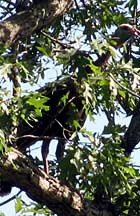
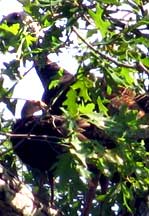
Just a sound, then a rustling of leaves, call attention to wildlife camouflaged in a tree.
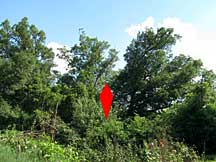 The pointer calls attention to the area of our property where the hens were spotted.
The pointer calls attention to the area of our property where the hens were spotted.
So, I am out in the garden rummaging through the vegetable beds for our dinner on Saturday afternoon, and I hear a repeating cluck-type call high up in the trees south of the garden next to the pond. Scanning the trees produced nothing, until a rustle of activity and leaves caught my eye. I am hearing a hen turkey calling her two young turkeys roosting with her. They are up about 50 to 60 feet in the tree.
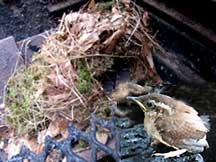
A baby wren had called the top of our outdoor grille home.
And if you think spotting the hen turkey sent me for my shotgun and the choice of meat instead of a vegan menu consider how often the grill is used in our house.
Enjoy this "History of Wild Turkeys in Missouri" thanks to the Missouri Department of Conservation:
The wild turkey is native to North America and is believed to have originated in Mexico. Six subspecies are currently recognized, with the Eastern subspecies occurring in Missouri. During the 1800s, the North American continent was home to an estimated 10 million wild turkeys. However, destruction of habitat and unregulated hunting reduced the North American population to approximately 300,000 birds by 1950.
In Missouri, wild turkeys were found in large numbers throughout the state. From 1840 until about 1900, historians recorded "too many wild turkeys even to consider raising tame birds" and "turkeys so numerous and easily obtained as to be scarcely worthy of consideration." Sixty years later the Missouri turkey population had been reduced from 250,000 to approximately 3,000 birds and most were limited to remote Ozark regions. With the destruction of timber by fire and ax, open grazing of the forest, and market hunting, the wild turkey in Missouri was brought to near extinction.
From 1925 to 1943, an effort was made to halt the decline in turkey numbers. Approximately 14,000 game farm turkeys were released to supply more breeding stock. The hunting season for turkeys was closed in 1937. However, turkey numbers still decreased and the release of game farm turkeys appeared futile. Research studies were initiated in 1938 to determine why the game farm turkeys failed. These investigations were interrupted during World War II, but resumed in 1951. It was learned that game farm birds, even of the wildest stock obtainable, were not the answer- only a truly wild bird would survive.
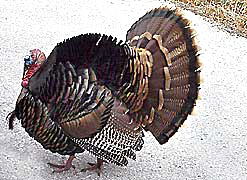
This tom was spotted a few years back on a rural road leading into Neosho.
It became evident that restocking wild turkeys to unoccupied range was the solution to restoring the species, but it could not be done easily. First, a source of native wild turkeys was needed. Secondly, a method of trapping wild turkeys had to be developed, and finally, captured turkeys would need to be released in areas where their chance of survival was high.
To ensure a source of wild birds, the Department of Conservation bought a large tract of land in the southern Ozarks where there were still a few native wild turkeys. Providing protection to the birds and restoration of food and cover on this tract of land paid off. By 1954, the population on the 23,000-acre Peck Ranch Wildlife Area had increased from nine turkeys to 32. Trapping began in 1957 on an 11,000-acre, intensively managed portion of the ranch that supported about 100 birds. Management practices on Peck Ranch demonstrated that turkeys could be abundant again.
An efficient method of turkey trapping still needed to be developed. A few turkeys were taken incidental to deer trapping, but the large cumbersome deer traps were not adaptable to an intensive turkey trapping program. The answer was an adaptation of the cannon-net trap used for capturing waterfowl. The only problem was to get the turkeys to the trap site; this was achieved by baiting. Finding suitable release sites for captured turkeys involved many factors. An important component of the release site was strong public support. Communities were encouraged to submit a request for restocking and the requests were evaluated for general habitat conditions.
All 114 Missouri counties now have huntable turkey populations with 101 of these counties having populations as a result of restocking. Missouri has made important contributions to restoration programs in other states, as well, by swapping Missouri wild turkeys for other wildlife species. Since the early 1960s, Missouri has traded turkeys for ruffed grouse, otters, pheasants, prairie chickens and various kinds of fish.
As research continues and populations expand further, the understanding of wild turkeys in Missouri improves. For example, the ideas regarding optimal habitat have changed greatly. Highest turkey densities now occur in agricultural regions of the state where crop fields, old fields and timber are well interspersed. High turkey populations exist in counties with less than 20 percent timber. Obviously, the wild turkey is much more adaptable than previously thought and prospects for continued high populations of wild turkeys in Missouri are excellent.
Is the MDC suggesting we clean and fire up the grill?
Commentary and photos by May Belle Osborne and Mark Adams, Neosho






Comments